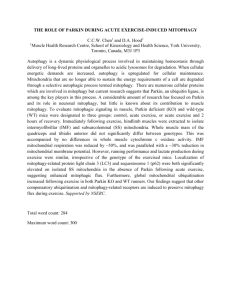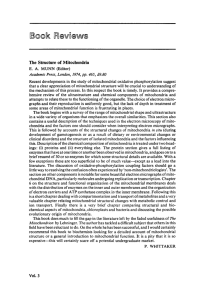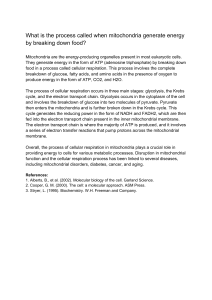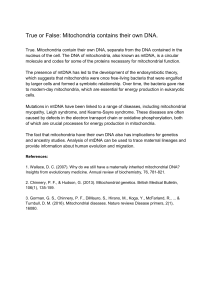Mitochondrial dysfunction and mitophagy failures in Alzheimer’s disease (1)
advertisement
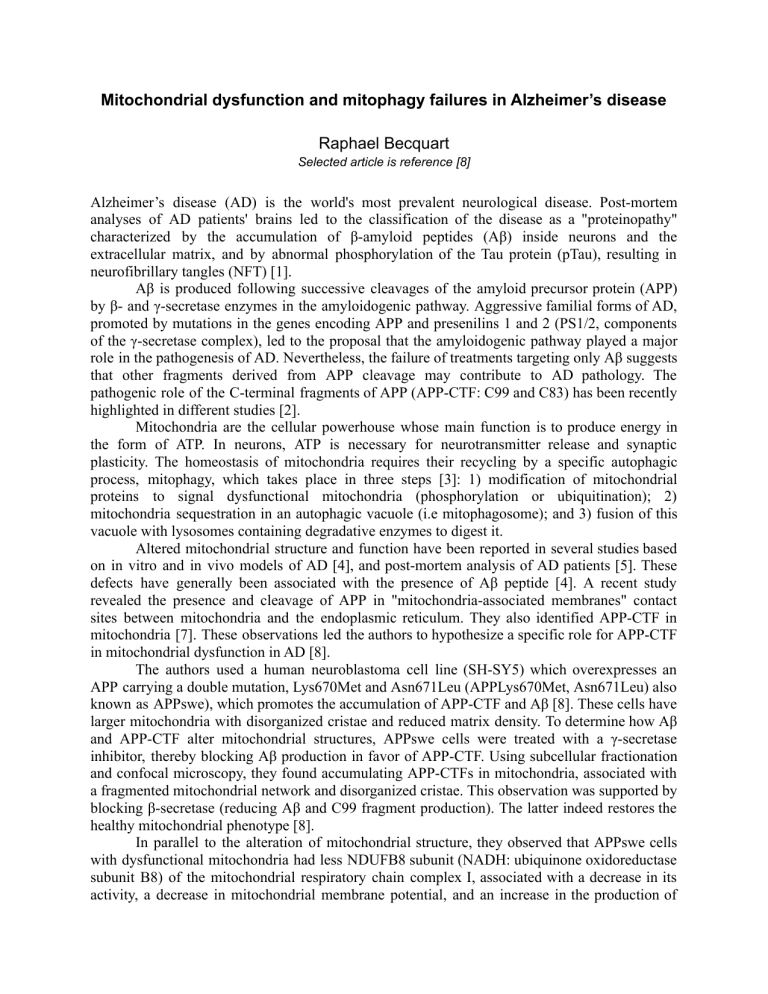
Mitochondrial dysfunction and mitophagy failures in Alzheimer’s disease Raphael Becquart Selected article is reference [8] Alzheimer’s disease (AD) is the world's most prevalent neurological disease. Post-mortem analyses of AD patients' brains led to the classification of the disease as a "proteinopathy" characterized by the accumulation of β-amyloid peptides (Aβ) inside neurons and the extracellular matrix, and by abnormal phosphorylation of the Tau protein (pTau), resulting in neurofibrillary tangles (NFT) [1]. Aβ is produced following successive cleavages of the amyloid precursor protein (APP) by β- and γ-secretase enzymes in the amyloidogenic pathway. Aggressive familial forms of AD, promoted by mutations in the genes encoding APP and presenilins 1 and 2 (PS1/2, components of the γ-secretase complex), led to the proposal that the amyloidogenic pathway played a major role in the pathogenesis of AD. Nevertheless, the failure of treatments targeting only Aβ suggests that other fragments derived from APP cleavage may contribute to AD pathology. The pathogenic role of the C-terminal fragments of APP (APP-CTF: C99 and C83) has been recently highlighted in different studies [2]. Mitochondria are the cellular powerhouse whose main function is to produce energy in the form of ATP. In neurons, ATP is necessary for neurotransmitter release and synaptic plasticity. The homeostasis of mitochondria requires their recycling by a specific autophagic process, mitophagy, which takes place in three steps [3]: 1) modification of mitochondrial proteins to signal dysfunctional mitochondria (phosphorylation or ubiquitination); 2) mitochondria sequestration in an autophagic vacuole (i.e mitophagosome); and 3) fusion of this vacuole with lysosomes containing degradative enzymes to digest it. Altered mitochondrial structure and function have been reported in several studies based on in vitro and in vivo models of AD [4], and post-mortem analysis of AD patients [5]. These defects have generally been associated with the presence of Aβ peptide [4]. A recent study revealed the presence and cleavage of APP in "mitochondria-associated membranes" contact sites between mitochondria and the endoplasmic reticulum. They also identified APP-CTF in mitochondria [7]. These observations led the authors to hypothesize a specific role for APP-CTF in mitochondrial dysfunction in AD [8]. The authors used a human neuroblastoma cell line (SH-SY5) which overexpresses an APP carrying a double mutation, Lys670Met and Asn671Leu (APPLys670Met, Asn671Leu) also known as APPswe), which promotes the accumulation of APP-CTF and Aβ [8]. These cells have larger mitochondria with disorganized cristae and reduced matrix density. To determine how Aβ and APP-CTF alter mitochondrial structures, APPswe cells were treated with a γ-secretase inhibitor, thereby blocking Aβ production in favor of APP-CTF. Using subcellular fractionation and confocal microscopy, they found accumulating APP-CTFs in mitochondria, associated with a fragmented mitochondrial network and disorganized cristae. This observation was supported by blocking β-secretase (reducing Aβ and C99 fragment production). The latter indeed restores the healthy mitochondrial phenotype [8]. In parallel to the alteration of mitochondrial structure, they observed that APPswe cells with dysfunctional mitochondria had less NDUFB8 subunit (NADH: ubiquinone oxidoreductase subunit B8) of the mitochondrial respiratory chain complex I, associated with a decrease in its activity, a decrease in mitochondrial membrane potential, and an increase in the production of reactive oxygen species in the mitochondria. Furthermore, the authors showed that the accumulation of APP-CTFs in mitochondria, independent of Aβ, exacerbates the production of reactive oxygen species. Finally, by analyzing a cell model expressing the C99 fragment of APP in an inducible manner (SH-SY5Y C99 cells), they confirmed the impact of APP-CTF on mitochondrial dysfunctions. Indeed, this model shows an accumulation of APP-CTF in the mitochondria, a defect in the expression and activity of complex I of the respiratory chain, and an overproduction of reactive oxygen species [8]. The absence of an apoptotic phenotype in SH-SY5Y APPswe and SH-SY5Y C99 cells treated with the γ-secretase inhibitor led the authors to focus on mitophagy. Using biochemical approaches combined with subcellular fractionation, they quantified different molecular markers of mitophagy and analyzed the different steps of the mitophagic process with fluorescent probes. In SH-SY5Y APPswe cells, the first steps of the mitophagic process were observed: enrichment of PINK1 (PTEN-induced kinase 1) protein in the mitochondrial fraction, parkin recruitment to the mitochondria (a ubiquitin ligase), and the conversion of the cytosolic LC3-I form of MAP1LC3 (microtubule-associated protein 1A/1B-light chain 3) into LC3-II, the form recruited to the autophagosome membrane. However, they found that mitophagy was inhibited, as revealed by the absence of degradation of the SQSTM1/p62 protein (sequestosome 1 or p62 ubiquitin-binding protein) and by the accumulation of several mitochondrial proteins (TIMM23, TOMM20, HSP60, and HSP10). This failure of mitophagy was confirmed as mitochondria could not fuse to lysosomes. The authors then showed that APP-CTF accumulation, independent of Aβ, exacerbates mitophagy failure in SH-SY5Y APPswe and SH-SY5Y C99 cells [8]. Postmortem biochemical analysis of brains from patients with advanced non-familial forms of AD demonstrates accumulation of APP-CTF (C99 and C83) and Aβ in the mitochondrial fraction, coupled with a defect in mitophagy characterized by decreased amounts of PINK1 and parkin in the mitochondria, increased LC3-II/LC3-I ratio and SQSTM1/p62 protein. The authors reported a significant correlation between the levels of the C99 fragment and changes in the mitophagic markers. However, these correlations were weak with levels of Aβ and pTau. This result validated in human samples the results previously obtained in cellular and animal study models mimicking genetic forms of AD. In all, independently of the action of Aβ, the accumulation of APP-CTF fragments leads to a deterioration of mitochondrial structure and function, and a blockage of the mitochondria turnover (mitophagy) [8]. The accumulation of defective mitochondria associated with disruption of mitophagy is common to various neurodegenerative diseases, such as Parkinson's disease, Huntington's disease, amyotrophic lateral sclerosis, and AD. Restoring normal mitophagic function could therefore be considered a new therapeutic goal in AD and other neurodegenerative diseases. This article is relevant to lecture 3 where protein aggregation was discussed. The cleavage of APP by secretases is not biochemically optimal as Aβ and APP-CTF fragments can both accidentally result from a naturally occurring reaction that serves homeostatic functions, to a significant degree where they initiate pathogenesis. A potential explanation for this suboptimality is the fact that humans have not evolved to live long enough for natural selection to have developed robust repair systems that work during old age, or optimized metabolic reactions that do not produce such accumulating molecules. References [1] De Strooper B, Karran E. The cellular phase of Alzheimer’s disease. Cell 2016 ; 164 : 603–615. [2] Nhan HS, Chiang K, Koo EH. The multifaceted nature of amyloid precursor protein and its proteolytic fragments: friends and foes. Acta Neuropathol 2015 ; 129 : 1–19. [3] Onishi M, Yamano K, Sato M, et al. Molecular mechanisms and physiological functions of mitophagy. EMBO J 2021; 40 : e104705. [4] Atamna H, Frey WH, 2nd. Mechanisms of mitochondrial dysfunction and energy deficiency in Alzheimer’s disease. Mitochondrion 2007 ; 7 : 297–310. [5] Manczak M, Park BS, Jung Y, Reddy PH. Differential expression of oxidative phosphorylation genes in patients with Alzheimer’s disease: implications for early mitochondrial dysfunction and oxidative damage. Neuromolecular Med 2004 ; 5 : 147–162. [6] Reddy PH, Oliver DM. Amyloid beta and phosphorylated Tau-induced defective autophagy and mitophagy in Alzheimer’s disease. Cells 2019 ; 8 : 488. [7] Del Prete D, Suski JM, Oules B, et al. Localization and processing of the amyloid-beta protein precursor in mitochondria-associated membranes. J Alzheimers Dis 2017 ; 55 : 1549–1570. [8] Vaillant-Beuchot L, Mary A, Pardossi-Piquard R, et al. Accumulation of amyloid precursor protein C-terminal fragments triggers mitochondrial structure, function, and mitophagy defects in Alzheimer’s disease models and human brains. Acta Neuropathol 2021; 141 : 39–65.



